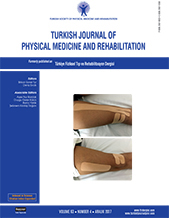The investigation of the role of the facet joint angle in the development of L5-S1 spondylolysis in young men
2 Department of Orthopedics and Traumatology, Aksaz Military Hospital, Muğla, Turkey
3 Department of Radiology, Mevki Military Hospital, Ankara, Turkey
4 Department of Physical Medicine and Rehabilitation, TSK Rehabilitation Center, Ankara, Turkey
5 Department of Neurosurgery, Mevki Military Hospital, Ankara, Turkey
6 Department of Neurosurgery, İstanbul Sultan Abdülhamid Han Training and Research Hospital, İstanbul, Turkey DOI : 10.5606/tftrd.2017.295 Objectives: This study aims to evaluate facet tropism in younger patients with lumbar spondylolysis and to investigate the role of facet tropism in the development of spondylolysis.
Patients and methods: Between February 2013 and December 2015, a total of 102 male patients with bilateral L5 pars defect including 53 with spondylolysis and 49 control subjects were included in this case-control study. The facet joint angles were measured bilaterally and axially at the level of L3-4, L4-5, L5-S1 using computed tomography (CT). The classification was made as follows: A difference between two reciprocal facet joint angles of <6° indicated no tropism, 6°-12° indicated moderate tropism, and >12° indicated severe tropism.
Results: A total of 612 angles including 318 facet joint angles from 53 patients with spondylolysis and 294 facet joint angles from 49 control subjects were measured. L3-4 measurements in the control group showed no tropism in 87.8% (n=43), moderate tropism in 12.2% (n=6), and severe tropism in 0% (n=0). L4-5 measurements in control group showed no tropism in 79.6% (n=39), moderate tropism in 20.4% (n=10), and severe tropism in 0% (n=0). L5-S1 measurements in the control group showed no tropism in 69.4% (n=34), moderate tropism in 28.6% (n=14), and severe tropism in 2.0% (n=1). The mean facet joint angles in the spondylosis group were 32.9±5.1°, 37.5±5.4°, and 41.2±7.8° at the levels of L3-4, L4-5, and L5-S1, respectively. The mean facet joint angles of the control group were 33.2±5.7°, 39.7±4.9°, and 42.2±4.9° at the levels of L3-4, L4-5, and L5-S1, respectively, indicating no significant difference between the right and left mean facet joint angles between the groups (p>0.05). The frequency of facet tropism and the difference between right and left facet joint angles for all three levels were significantly higher in the spondylolysis group (p<0.05). Facet tropism at the level of L5-S1 was significantly more frequent than facet tropism at L3-4 level (p<0.05).
Conclusion: Our study results show that the rate of facet joint tropism is higher in the patients with spondylolysis, suggesting that facet tropism seems to play a role in the etiology of spondylolysis as a predisposing factor.
Keywords : Facet joint; spondylolysis; tropism; young adult

















